May 2016
4 Tricky Social Media Challenges & How to Solve Them
- by Alyson Shane
Let's face it: social media is challenging, and most people feel totally overwhelmed when they first sign up for a social network without any prior knowledge of how to use it.
This is totally normal, but unfortunately it's the reason that many people sign up for social networks, spend a little bit of time trying to get to know them... and then promptly abandon them when they encounter a challenge (like getting new followers, or having authentic conversations) that they don't know how to overcome.
Stop the madness! While social media can certainly be complicated and feel challenging (trust me, I know) it's not rocket science, and with that in mind I wanted to cover four of the biggest, trickiest challenges that people ask me about on a regular basis.
Let’s jump in!
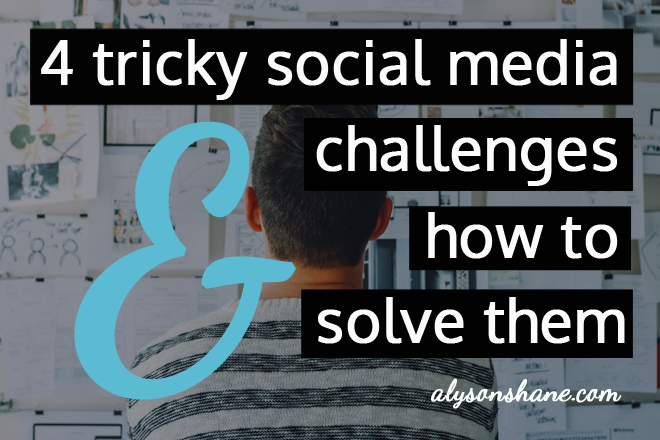
Challenge #1: Creating an authentic connection
One of the things that people seem to struggle with the most when it comes to interacting on social media is authentic interactions. An "authentic interaction" is when a person or brand takes the time to get to know their audience on a personal level by interacting with them in a natural, non-salesy way, and is an important part of building feelings or trust and familiarity online.
How to solve it
The easiest way to create an authentic connection online is to be legitimately interested in other people, and to engage with them in a variety of positive ways. These can include:
- Asking questions
- Sharing links to articles and blog posts
- Responding to posts, tweets and comments
- Offering advice or a solution to someone's problem
One of my favourite ways to engage with other people is to find relevant Twitter chats and participate regularly. Never participated in a Twitter chat? Don't worry, I have a whole series called the Twitter Crash Course to get you started.
Challenge #2: Developing a social media strategy
Most people are on social networks without much of a plan, but when you make the decision to start investing the time and energy into growing your audience, it's time to sit down and start planning how to do it.
How to solve it
There are lots of things that you can do to pave your path to social media success, but a few of the most basic ones you ought to have figured out before diving in are:
- Why you're on social media. Don't just say "because everyone else is"! Legitimately ask yourself why you want to invest your time growing an online audience and let those goals guide your actions.
- How you're going to achieve those goals. Maybe you'll put together a kickass paid advertising campaign, maybe you'll start sharing hilarious cat videos, whatever the case may be.
- How will you measure success? There are lots of ways you can measure success: number of page views, tweets, responds etc over a specific period of time, etc. What matters is that you keep records (I do mine on a monthly basis) to track your progress.
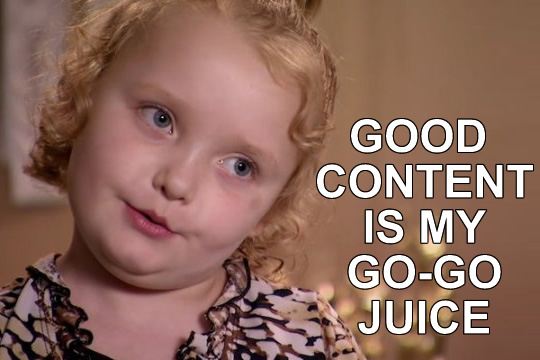
Challenge #3: Creating engaging, quality content
If you think that consistently coming up with good, consistent content for your social media feeds and blog is challenging and time-consuming... well, you're right. In fact, it's exactly why people like me exist: because most people simply don't have the time to create, update, curate, monitor, respond, and schedule content across multiple social media profiles.
But if you're not ready to invest in someone else handling your content for you, it can feel like an overwhelming amount of work, and is often something that leads to people avoiding or abandoning their social profiles entirely.
How to solve it
One of my favourite ways to suss out high-quality content ideas is to use a great tool called Buzzsumo, which allows you to punch in topics or websites and see the most popular posts about those topics. You can also try finding relevant Twitter chats and paying attention to what people discussing your industry or products are asking, or searching forum websites for questions and discussion threads.
When posting articles, make sure to use eye-catching images whenever possible; if you're sharing a link an image from the page will usually auto-generate (it's usually fine to just use these instead of your own), but if you're posting links to your own blog posts and content, take the time to create a unique and original image to go along with it.
Challenge #4: Getting the word out about your content
Unfortunately setting up a blog and social feeds doesn't necessarily mean that people will immediately flock to you (I wish it were that easy!) - you'll have to hustle your content in order for people to know that it's there. No matter how great your content may be, if you aren't promoting it then nobody is likely to find it.
How to solve it
The trick to getting your content out there is to be proactive in sharing it and encouraging other people to share it, as well. Try and identify people who would benefit from seeing your content and make a point to share it with them. There are a few ways that you can accomplish this:
- Share your blog or website updates on social media.
- Reach out to influencers in your industry (in a nice, non-sleazy way) and ask them to share it or work with you to promote your content.
- Tag people you mention in your post. For example, last year I wrote a post about the Winnipeg Folk Festival and tagged them in the tweet, which they retweeted and subsequently earned me a lot of traffic.
- Post links to your content on relevant Facebook or LinkedIn groups, Pinterest groups, and forum websites like Reddit and HackerNews (be sure to mind the posting rules on these sites!)
- Repost your content on Medium.com, and reach out to publications to see if they would be interested in republishing your work.
There you have it! Four steps to social media success and overcoming some of the trickiest obstacles that people face when they first start wading out into the big, wide world of social networks.
Do you have any social media challenges you struggle to deal with, or tips for overcoming some of these tricky issues? Tell me in the comments or tweet at me!
How Social Media & Blogging Helped Me Discover Who I Am
- by Alyson Shane
**Trigger warning** For some of you who come from abusive relationships, some of the content in this post may act as a trigger. Please read responsibly.
The other day Meg Athavale of LUMO shared a terrific article on Facebook called "The Psychological Price of Entrepreneurship" and one of the sections of the article really stood out for me:
Rather than showing vulnerability, business leaders have practiced what social psychiatrists call impression management--also known as "fake it till you make it."
This really struck a chord with me because as someone who makes their living online, keeping my personal brand as authentic as possible is one of my biggest priorities. Sure, I may not blog or tweet about every tough therapy session or anxiety that pops up, but as a business owner with an audience I believe that I have a responsibility to be transparent about the challenges in my life as well as my successes. I am a human being, after all.
With that in mind, I wanted to discuss the struggle that I've faced with reconciling my "authentic self" (aka, the one you see here, on social media, and in person) with the person that I was raised to believe that I was.
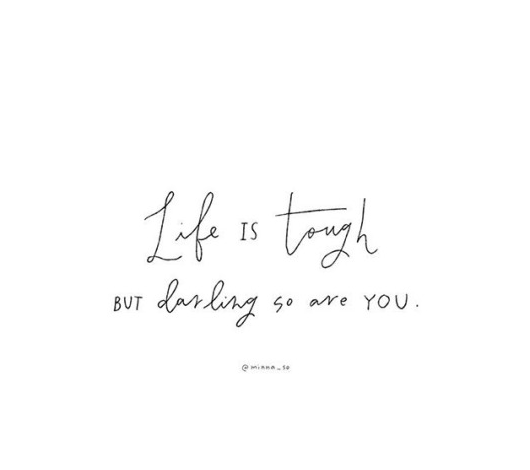
Some backstory
For those of you who don't know me personally, I haven't spoken to my parents or the majority of my family since early 2015 (you can read more about that here). Recently my brother had a baby, and I had to make the decision to not reach out or be involved. This wasn't a decision that I made lightly, but it was the right one for me and my mental health, and I stand by it.
This decision prompted my mother to leave a comment on my blog. Some of her statements (minus the attempts at gaslighting) included:
- For some reason Alyson, which I have to confess, escapes me, you seem to be under the impression that you are far superior to the rest of us.
- Maybe because you are a, 'writer', and can use, 'big', words, you think it gives you an advantage that we don't have.
- I think you need to get down off that pedestal you've erected for yourself and get rid of your overblown ego.
- You are so focused on living up to your superficial, 'queen of the Internet', alter ego, that you no longer know how to be a decent human being.
- Could it be that there is a wee bit of human in you after all?
The reason that I'm sharing these personal details is because I don't believe that vague descriptions adequately convey the narrative I grew up with. The comments you see above (which thankfully aren't a part of my life anymore beyond being a very helpful example for the sake of this article) were the things that were told to me on a daily basis.
Needless to say I entered adulthood as a pretty unhappy, insecure, and confused individual.
Discovering myself online
When I first started blogging back in 2003 I couldn't have predicted the multitude of ways that it would eventually come to change my life. I've always gravitated towards writing as my favourite form of self-expression, and blogging has always seemed like a natural and easy way to do it.
My blog is a reflection of who I am and the things that I feel are valuable and important to share, and from day one it caused issues between myself and my family. As illustrated in my mother's comments above, my ability to articulate and share my thoughts, and my willingness to do so, was seen as attempts at being superior and were frequently thwarted with threats of getting "cut out" of the family.
Despite this resistance from my home life I soon realized that I had found a community of like-minded individuals who wrote, shared, and published with the same authenticity that I wanted to be doing. In the late 2000's I started reading Raymi the Minx, the busblog, oceanaria, and a plethora of now-defunct but wonderful blogs who inspired me to be myself, no matter what. I'd always grown up believing that "nobody cared" about my thoughts or feelings, and the blogging community taught me that it wasn't true.
Around 2009 I also began discovering social networks. In particular I gravitated towards Twitter, which helped me express myself and connect with people whom I likely wouldn't have met otherwise. I doubt that I would have met Stef, Colin, Adrian, LJT, Kevin, and a variety of other wonderful people whom I now count among my dearest friends if it hadn't been for Twitter, and being active on this social network helped me expand my reach and connect with colleagues, clients, and a support system that I had never imagined was possible.
Around 2011 my active presence online as well as my obsession with internet culture and memes led to some of my Twitter followers (jokingly) dubbing me the "Queen of the Internet". As odd as it sounds, this nickname, however in jest, helped me start to develop a confidence that I had never experienced before. Suddenly people were turning to me to ask questions about social media and blogging on a regular basis. I started speaking at Red River College's Creative Communications program, at the MBlog conference, and my work was published in the local paper.
Contrasting these successes against the person that I had always believed myself to be (the selfish, superficial person who didn't care about anyone but herself) became harder and harder. Not only were my friends, colleagues, and peers informing a narrative which challenged my previous thoughts and feelings about myself, but I was starting to slowly stop believing those things, as well.
The catalyst
In retrospect the biggest change in perspective came when I published my post Living with the Mean Reds, which detailed how it felt to live with anxiety and feelings of low self-worth every day. At the time I was terrified of hitting "publish", and I was overwhelmed and surprised at the outpouring of support and kind words that I received as a result.
Social media and blogging provided me with a supportive community where over time I was able to learn to shed the negative self-image that I'd grown up believing. By having a space that was completely free from my family's influence I was able to start growing, learning, and not being so afraid all the damn time. I started a business, I started therapy, and I started investing my time and energy into the things that really mattered instead of indulging in drama because I felt obligated to participate

Support from these communities help me finally realize that refusing to make room for the negative things in my life doesn't make me a bad person. It means I have a deep enough understanding of my needs to make hard (and sometimes unpopular) decisions.
Why does this matter?
Social media and blogging are extremely powerful tools which can connect us with people all over the world. They allow us to find communities and support systems online we can start to explore parts of ourselves that scare us, or that we don't feel we can express to the people in our day-to-day lives.
By finding ways to express myself online I was able to discover things about myself, make connections, and find opportunities that simply wouldn't have been available to me otherwise. The encouragement I received from my followers, readers, friends, and my very supportive partner led me to where I am today, and though I'm not perfect I'm working hard at building the life I want and deserve.
Sharing this stuff isn't easy. It's doesn't feel great to admit that my mother is the way that she is, or that my family doesn't understand who I am, but it's the reality that I'm in and I'm thankful to be able to have a platform through which I can share these thoughts and experiences as I work through them.
Through blogging and on social media I was able to find a place for myself and connect with communities of supportive and like-minded individuals who helped me start making a place for myself in the real world and, most importantly, in my own eyes.
Most of the bloggers I've followed over the years don't know how much they helped me, and there's a good chance that if my words help someone that I may never know, either. But if reading about the challenges that I've faced helps someone else seek out the supports they need to start healing and being happy, then that matters a great deal, and I'm happy to share my stories and be a part of that process and thankful to be able to help.
As always, thanks for reading, and thanks for being here with me while I figure this stuff out.
(If anything I've described in this post re: family expectations, relationships, or narratives imposed upon you by your family sounds familiar, I strongly encourage you to check out /r/raisedbynarcissists, a wonderfully supportive Reddit community that has helped me a lot.)
6 Ways Your Small Business Can Save Money
- by Alyson Shane
Recently I received a phone call from my alma mater asking for donations to their Faculty of Arts, where I studied when I received my BA. She asked me for $5 a month, or "the cost of a single Starbucks coffee" (well played, University of Winnipeg, well played).
I'll be honest with you: I declined to give back to the university for the time being. My business is still in it's infancy, and saving money is pretty important to me right now. However, this conversation got me thinking about the ways I work to keep costs low for myself during this stage (even if that means saving that $5 a month), and I thought I'd share some of the things I've learned:
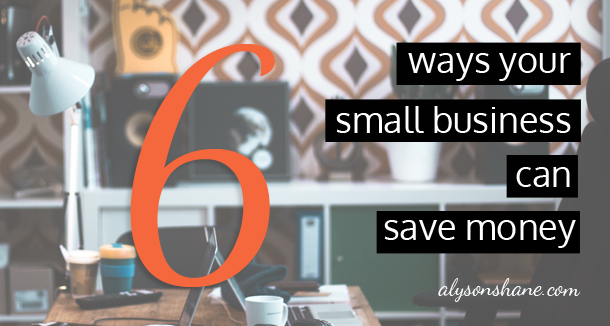
One of the most interesting assumptions that people have started to make about me since I began running my business is that this is the lifestyle I lead:

This is, much to my chagrin, not how I live my life. In fact, it's a little more like this:

Don't get me wrong, I'm doing just fine financially, but I'm not baller status quite yet. As a result, here are some of the areas where I cut costs or try not to indulge in order to keep my business expenses low:
Buying or renting space you don't need yet
One of the easiest ways to save a few hundred dollars a month (minimum!) is to avoid buying a brick-and-mortar store or renting office space for as long as you can. This, in my opinion, is the single biggest benefit to working from home.
Sure, there are benefits to an office or renting a desk in a co-working space, such as access to a board room, printing area, etc, but unless your business has grown to the point where you need those things on a consistent basis, having client meetings in coffee shops should be fine for now.
Spending on expedited shipping
Unless it's a business emergency (ie: your business will shut down without this parcel/package) you can wait the extra day or two.
Additionally, if the shipping charges for a particular item are outrageous, ask yourself: do you really need that beautiful embossed day planner that badly? Odds are, you probably don't.
Custom website design
I get it: you want to build a website that stands out from your competitor's. You want something that is completely yours, and is an accurate online representation of your business and your values.
However, what's more important is simply having a website, rather than worrying about whether or not it's built custom from scratch. Many people choose to work with existing Wordpress or Squarespace templates, which are easy to alter and personalize without the investment in a custom designed site.
Unnecessary advertising
I'm a firm believer that the best thing a person or business can do for themselves is to start to build a positive reputation for themselves online. What's great about this is that social networks like Facebook, Twitter, LinkedIn and Pinterest (the biggest and most popular ones for businesses) are all free to join.
This means that if you do hustle a little bit (or hire someone like me #ShamelessPlug) you can start to build a name for yourself and your services without having to invest in paid advertising just yet.
Not only does putting off doing paid advertising beneficial because it keeps costs low, but people will appreciate that you're connecting with them on a real, human level, and not just sending a barrage of ads their way.
Office supplies you don't need
Confession: I LOVE going to stationery stores. Every time I step into Tiny Feast here in Winnipeg my heart starts going pitter-pat and I start imagining how charming my desk would be with all those fountain pens, notebooks, staplers... you get the drift.
As much as I would love to take everything from Tiny Feast home with me, I have to ask myself: how often do I use a stapler (never), how often do I use paperclips (also never), do I really need a handmade mug to store my pens (not at all)... you get my drift.
As tempting as it may seem to try and pimp out your desk with heaps of Pinterest-worthy goodies, resist the temptation for now. You can always indulge in that gorgeous cork-top desk in the future.
Subscriptions for software you don't need
This one always gets me. I pay for a few subscriptions to various content scheduling and monitoring services (HootSuite, Buffer, etc) and it sucks to pay the monthly fees... but without them I would go absolutely bonkers and not be able to manage my shit. So, for me they are a necessary evil.
However, unless you're in the digital marketing business odds are you can avoid a lot of these monthly expenses by using free software to do what you need. Some great options are:
- Insightly (CRM system)
- Freshbooks (accounting)
- HootSuite or Buffer (free versions - social media management)
- Toggl (time management - I'd be lost without this tool)
- Trello (project management)
- Dropbox (file sharing)
It may seem tempting to invest in expensive software, or to buy a bunch pf products up-front "just in case" but if you aren't using the tool on a daily basis, and if it isn't something that your business can live without (eg: I would be utterly lost without Buffer, for example) then consider sticking with the free version, or finding a free alternative until the time comes when you either a) need the service enough that you should pay for it or b) you can afford to invest in it.
Do you have any money-saving tips for small businesses? Is there something that you wish you had learned when you were starting out? Tweet at me or tell me in the comments!
How to Create Buyer Personas That Work for Your Business
- by Alyson Shane
Let me tell you a dirty secret: I hated building buyer personas when I was taking my business courses in university. I thought they were useless, frivolous, and something that marketing agencies could charge exorbitant fees to their customers to develop.
Then, as it so often happens in the world of Being an Adult, I started running my own business and learned that I was totally wrong.
In fact, understanding and developing buyer personas was, in fact an integral part of understanding a businesses' target audience, and how best to communicate with them.
As I so often say when it comes to advice I dole out on this blog: do as I say, not as I've done. Learn from my mistakes; understand what a buyer persona is and how it benefits your business, and use it to the best of your abilities.
Not sure what a buyer persona is, or how it can help your business? No worries, I've got you covered:
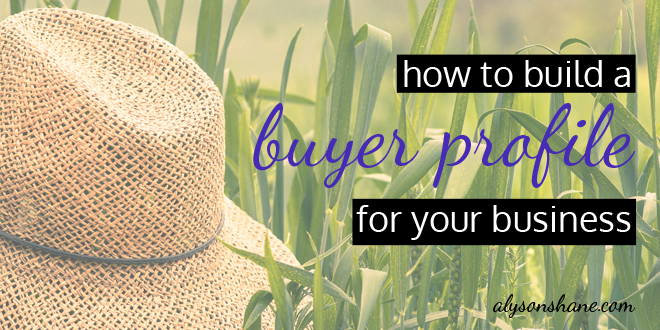
What are buyer personas & what do they do?
At it's core, a buyer persona is essentially a portrait of your ideal customer.
In terms of content marketing strategy, having a comprehensive buyer persona helps businesses (or people like me!) deliver content which is timely, informative, and that your audience actually want to see and consume.
Different people respond differently to various kinda of images, messaging, and communication, and it's important to take these perspectives into consideration while figuring out how to best serve your customers.
For example, a 20-year-old Snapchat user who is starting university and has very little disposable income will have respond to different messages, and will have different motivations, goals, and purchasing power than a 45-year-old father of two who is a CEO at his company and has lots of disposable income. Now, your business may not be trying to appeal to both of these extremes, but what this is meant to illustrate is that you need to know who your ideal buyers are, why they should care about your business, and (more importantly) how your product or service can appeal to them or make their lives easier.
How can you build buyer personas that really work?
The key to building effective buyer personas is that you have to make a bunch of them. This may feel like tedious work (my university-era self would agree) but creating a few personas can help you develop well-rounded ideas about the kinds of people you want to communicate with, and who you think are the ones who would be interested in buying what you have to offer.
You don't have to get super specific, but identifying the following areas are generally pretty useful:
Basic info
- Name. This isn't technically necessary, but I like naming my buyer personas. I find it helps with keeping track of who they are, and makes them feel a bit more "real".
- Job title. Are they CEOs? Mid-level management? Students working at Starbucks? Like I said earlier, where they are in their professional life will influence their purchasing power.
- Details about their job title or role. These flesh out their day-to-day motivations at work and help inform what they may be looking for professionally.
General demographics
- Age. Different generations and age brackets have different motivations and priorities, and it's important to identify what they are in order to figure out what they want.
- Gender. Are you marketing your products to men, women, both, or otherwise?
- Location. Where your ideal customers are can make a huge difference on how you craft your message to them.
- Salary. Lots of people are afraid to talk about money and finances, but let's be honest: how much your buyers have to spend influences whether or not they have monty to buy your products or services.
- Education. People's level of education shapes a variety of areas such as their level of employment, salary, interests, and much more.
- Family. Are they single? Married? Do they have 2.5 kids? Are they close with their extended family? Their ties to their families and those obligations will influence their purchasing power.
Values & objections
- Values. What are the things that your buyers believe to be important or valuable? Eg: buying local; investing in secondhand or slow fashion; or driving an expensive BMW.
- Objections. What are some objections that could come up during the sales process? Eg: your product is too expensive; too niche; too complicated for a layman to see any value, etc.
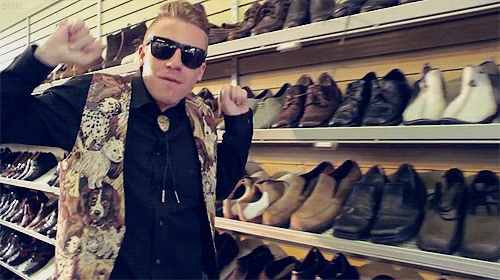
(do your buyers shop like Kanye or like Macklemore?)
Extras
This area can change a bit depending on what your business sells, but generally some other areas which can help build an accurate buyer profile are:
- Computer literacy. Do your buyers go mining for Bitcoins, or do they struggle to find the Any Key?
- News sources. Your customers' values will likely be different depending on whether they get their news from Fox News or Al-Jazeera.
- Hobbies. How your customers spend their free time can help you understand more about their motivations and values.
- Interviews and real-life examples. If you already have an existing customer base, take a look at your reviews and customer service experiences. How do people talk to your team, or speak about your business?
Sussing this information out
Figuring out all this information by yourself may seem like an impossible task, but it isn't! There are actually a variety of ways that you can find the information you need to build a series of effective buyer personas, which are:
- Asking your team and colleagues. As I said earlier, if your business is already customer-facing you can speak to team members who interact with your customers to build complete profiles.
- Check your website stats. This should be obvious, but if not some things to look for are: keywords people used to find your website, where your visitors came from, and the actions they took while they were on your page. If your website doesn't have Google Analytics installed, back the hell up and install it before coming back to this article. Your analytics tool is one of the best tools at your disposal for understanding customer behaviour.
- Use social media. Look for services or products similar to your own and spend some time analyzing the discussions happening on Facebook, Twitter, LinkedIn, and on blogs. People are more likely to share negative experiences than positive ones online, which can provide you with important insight into the areas where your buyers feel your industry could be doing better.
Why does this process matter?
This may seem like a lot of work (and trust me, it is!) but taking the time to investigate and research your potential customers and to create well-rounded buyer personas can go a long way towards helping you understand your businesses' strengths and weaknesses. Spending time on this process helps your business provide a better experience for your customers.
Still want a little more help creating an effective buyer persona? Check out these free buyer persona templates from HubSpot. They're what I use day-to-day, and I'm sure you'll find them to be invaluable, as well!
How do you create buyer personas for your business? Do you have anything to add to what I've outlined in this post? Tweet at me or tell me in the comments!
A Guide to Working Your Side Hustle While Keeping Your Day Job
- by Alyson Shane
Let's face it: there's nothing worse than feeling like you're stuck in your job.
I'll be honest with you: I was pretty unhappy at my old office job, and the biggest thing that kept me going there day after day was knowing that I could go home and work on my business.
Knowing that I could go home and pour my energy into something personal that mattered to me kept me going on a lot of days when I wanted to throw in the towel.
However, whether you're building your biz on the side, hustling your freelance gig, or working on other creative projects, it can still be tough to be able to put the effort in when you spend the bulk of your peak productivity hours at the office.
If you're serious about accomplishing your goals outside of your 9-5 then it's time to start planning, getting organized, and taking steps to make the most of your out of office hours.
Luckily, I just went through this experience, which is why I'm here to help:
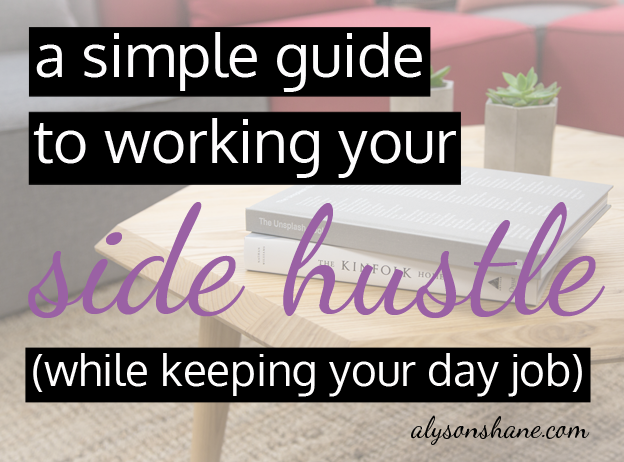
Figure out how much time you have (and be honest!)
So we already know that you have -40 hours a week to work on your side project, but it's also important to factor in other important areas of your life that can't be avoided and take up your time. Some of these can include:
- Commuting to and from work
- Going to the gym/general fitness
- Preparing and eating meals
- Socializing
- Sleep
The easiest way to figure out how much time you really have is to map it out so you can get an accurate look at how much time you really have, and how much time you can realistically spend each week.
I know that a few hours here or there may not look like a lot, but don't get discouraged! Make every hour count.
Plan, plan, plan!
Your time is limited, and if you're working on a particularly large goal, or something with lots of steps to complete it can feel like an impossible task to fit it all into your after-work hours. Don't sweat it, baby, it can be done! It just takes a little planning and preparedness.
The first thing you need to do is figure out what your goals are. They can be as vague or as specific as you'd like, but the most specific you can be, the better.
Some examples are:
- Write and publish an ebook
- Redesign and launch your website
- Put together an e-course or workshop
- Hustle your side business and grow your client base
These are all top-level goals: they're the end result, but to get there will take lots of smaller, much more manageable steps. What I used to do was sit down on a weekly or bi-weekly basis and figure out what I wanted to work on that week, and focused my attention on competing those tasks.
Prioritize and re-assess often
Once your top-level goals are in place and you've mapped out how and when you'll be taking steps to get there, it's time to prioritize your time. When you're doing lots of stuff and living a busy life it can feel hard to know what to start with (believe me!) so I find it's helpful to determine what "priority" tasks are. This is what mine look like:
- Client work and tasks that generate income
- Time-sensitive tasks, or tasks on a schedule (my newsletter, for example)
- Work that needs to be sent to someone else so they can move forward on their end
- To-dos on my business development goal list
It's important to take this seriously! It's way too easy to get wrapped up in small details, or to waste your time on something that doesn't really matter. Remember: your after-hours time is at a premium, so treat it that way.
Schedule similar tasks together
After a long day at the office it may feel like it makes more sense to say, write a blog post one night and draft your newsletter the next, but practicing "batch scheduling" can help you optimize your time and get more done.
"Batch scheduling" is exactly what it sounds like: grouping similar tasks together to optimize your time. This is especially important when doing tasks which require you to get into a "flow" such as writing or other creative pursuits. It takes time to get in and out of flow, so it makes more sense to group similar tasks together so you can stay in that mindset as you move from one task to the next.
It's also important to try and schedule your after-work work on nights when you aren't feeling mentally worn-down. You probably won't feel like sitting down and working on your financials after a busy day of meetings at the office, for example, so try to schedule mentally taxing tasks on days when your 9-5 is more low-key, and vice-versa.
Take time off
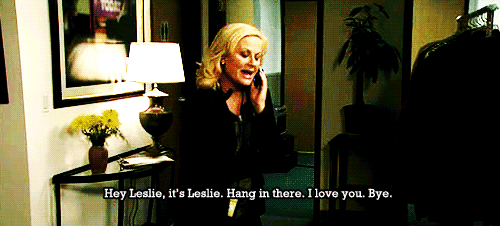
When you're hustling on the side of your 9-5 it's really easy to fall into the habit of working 24-7 (trust me on this one, I know it all too well) but if you don't schedule in time to rest and recharge your batteries you will burn out. Not only will your side projects begin to see the strain, but your productivity at your 9-5 will begin to slip as well, and that's not good!
With this in mind, schedule time to catch up on the latest Game of Thrones, go for a hike with your friends, or basically do something that isn't working on your side project when you're not at work.
Taking the time to look after yourself ensures that you'll have the steam to keep firing on all cylinders, both at your 9-5 and at your side gig, for a long time.
Do you have any tips for working on your side hustle while keeping a day job? I'd love to hear them!
